
Bell-bottoms (or flares) are a style of trousers that become wider from the knees downward, forming a bell-like shape of the trouser leg.

Bell-bottoms (or flares) are a style of trousers that become wider from the knees downward, forming a bell-like shape of the trouser leg.

In the early 19th century, when a standardised uniform for British ratings in the Royal Navy or enlisted men in the U.S. Navy did not as yet exist, some sailors adopted a style of wide trousers ending in bell-shaped cuffs. [1] [2] [3] In 1813, one of the first recorded descriptions of sailors' uniforms, written by Commodore Stephen Decatur, noted that the men on the frigates United States and Macedonia were wearing "glazed canvas hats with stiff brims, decked with streamers of ribbon, blue jackets buttoned loosely over waistcoats, and blue trousers with bell bottoms." [1]
The Royal Navy had often been a leader in nautical fashion, but bell-bottoms did not become part of the standard uniform until the mid-19th century. [2] These bell-bottoms were often just very wide-legged trousers, rather than shaped trousers that flared below the knee. [2] They continued in use as a distinctive feature of the RN rating's "square rig" uniform until replaced by more conventionally flared trousers in 1977. [4]
Although the trousers of the present-day uniform of the United States Navy are still referred to as bell-bottomed, they simply have large straight legs. The wearer's thigh fills the upper trouser leg, making the bottom of the pants leg appear flared. This style has been popular for many years, perhaps originally because the trouser leg can be rolled up easily, allowing the wearer to work in bare feet, but there is no reliable documentation that confirms a specific timeline or reason for the popularity of bell-bottomed trousers in naval apparel. [2] [3]
Some modern naval uniforms continue to use bell-bottomed trousers as a potential life-saving device. The trouser material is made of cotton fibers that swell when wet and can hold air. In the event of a sailor falling overboard or having to abandon ship without a life vest, the bell-bottomed trousers can be quickly removed in the water without having to remove footwear. As part of their survival training, sailors are taught to remove the trousers while floating, tie the leg bottoms in a knot, and then use one of several methods to inflate the trousers with air. The inflated trousers can provide extra flotation while awaiting rescue. [5]
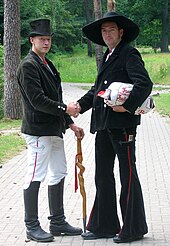
Bell-bottoms have also been worn for centuries by European carpenters, which is explained by the fact that the widening legs prevent sawdust from falling onto their shoes or feet. Bell-bottoms are still worn by carpenters who decide to spend their time after the apprenticeship as journeymen on the road.
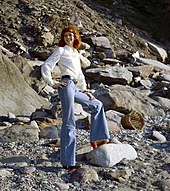
In the 1960s bell-bottoms became fashionable for both men and women in London and expanded into Europe and North America. [6] Often made of denim, they flared out from the bottom of the calf, and had slightly curved hems and a circumference of 18 inches (46 cm) at the bottom of each leg opening. They were usually worn with Cuban-heeled shoes, clogs, or Chelsea boots. Toni Basil, who was a go-go dancer when the 1964 concert film the T.A.M.I. Show was released, appeared in the film wearing bell-bottoms with a baby doll blouse.

Bell-bottoms are mentioned in the popular 1971 music single "Bell Bottom Blues" by blues-rock group Derek and the Dominos.
In the 1970s, bell-bottoms moved back into mainstream fashion via Brian Spiller; [6] Sonny and Cher helped popularize bell-bottoms in the US by wearing them on their popular television show. [6] The pants were typically flared from the knee down, with bottom leg openings of up to twenty-six inches. Made from denim, bright cotton and satin polyester, they were so popular that they became a symbol of the outlandish and colorful style of the decade. [7]
Loon pants (shortened from "balloon pants") were a variant on bell-bottomed trousers, with an increased flare. They were worn occasionally by go-go dancers on the British television music variety show Ready Steady Go! in 1966. [8]
Elephant bells, popular in the mid-to-late 1970s, were similar to loon pants, but were typically made of denim. Elephant bells had a marked flare below the knee, often covering the wearer's shoes. The preferred shoes were platform shoes with soles at least 2 inches (5.1 cm) thick and heels 4 to 5 inches (10 to 13 cm) to keep the pants' hems off the ground.
After the rise of punk rock in the late 1970s, bell-bottoms began to become less-fashionable as the decade drew to a close. By 1979, skin-tight trousers or 1950s-style drain pipes were much more in vogue, with bell-bottoms been seen as having had their day, remaining in fashion circa 1967–1979. [9]
A revival of bell-bottoms occurred after bands such as The Stone Roses, Happy Mondays and The Charlatans re-introduced them in late 1989 and the early 1990s.
In 1996, women's bell-bottoms were reintroduced to the mainstream public, under the name "boot-cut" (or "bootleg" [10] ) trousers as the flare was slimmer. [11] By 1999, flare jeans had come into vogue among women, [12] which had a wider, more exaggerated flare than boot-cuts. The boot-cut style ended up dominating the fashion world for 10 years. [13]
By around 2006, the bell-shaped silhouette started to fade as the skinny jean rose in popularity. [14] Sharon Haver, the founder and editor-in-chief of online fashion magazine FocusOnStyle.com, commented "It's as if all the girls wearing premium boot-cut jeans threw them away one day, and the next day began wearing skinny jeans and flats." [15]
Women's boot-cut jeans are tighter at the knee than men's, and flare out from knee to hem. Men's styles are traditionally straight-legged, although the pants came in a more flared style in the early and mid 2000s, but this was optional. The bell-bottoms of the 1960s and 1970s can be distinguished from the flare or boot-cut of the 1990s and 2000s by the tightness of the fabric at the knee.
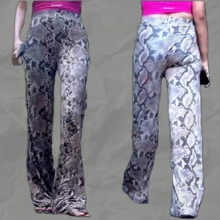
With the onset of a spectrum of revivalist fashion trends as a result of the COVID-19 pandemic, there has also been revived interest in clothing trends of the 1960s and 1970s, which includes bell-bottoms and flared trousers. [16] [17] [18] [19] Bell-bottoms were still trending on the runway in September 2022, [20] as well as the return to the wide leg bell-bottom in 2023. [21]
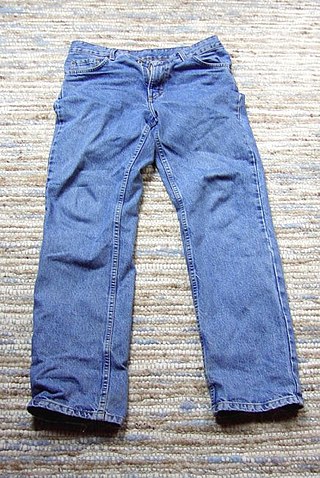
Jeans are a type of pants or trousers made from denim or dungaree cloth. Often the term "jeans" refers to a particular style of trousers, called "blue jeans", with the addition of copper pocket rivets added by Jacob W. Davis in 1871 and patented by Davis and Levi Strauss on May 20, 1873. Prior to the patent, the term "blue jeans" had been long in use for various garments, constructed from blue-colored denim.
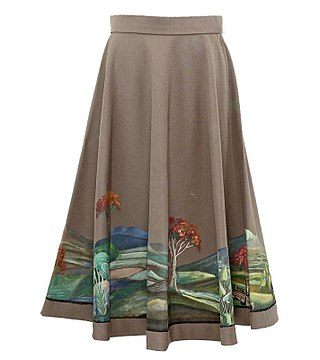
A skirt is the lower part of a dress or a separate outer garment that covers a person from the waist downwards.
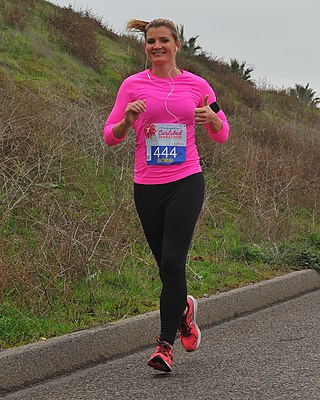
Leggings are several types of leg attire that have varied through the years. Modern usage from the 1960s onwards has come to refer to elastic close-fitting high-rise garments worn over the legs typically by women, such as leg warmers or tights. Usage from the 18th century refers to men's wear usually made of cloth or leather that is wrapped around the leg down to the ankle. In the 19th century, leggings usually referred to infants' leg clothing that were matched with a jacket, as well as leg-wrappings made of leather or wool and worn by soldiers and trappers. Leggings prominently returned to women's fashion in the 1960s, drawing from the form-fitting clothing of dancers. With the widespread adoption of the synthetic fibre Lycra and the rise in popularity of aerobics, leggings came to further prominence in the 1970s and 1980s, and eventually made their way into streetwear. Leggings are a part of the late 2010s into the 2020s athleisure fashion trend of wearing activewear outside sporting activities and in casual settings.
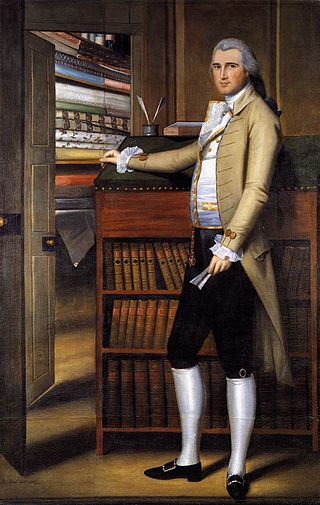
Breeches are an article of clothing covering the body from the waist down, with separate coverings for each leg, usually stopping just below the knee, though in some cases reaching to the ankles. Formerly a standard item of Western men's clothing, they had fallen out of use by the mid-19th century in favour of trousers.

Culottes are an item of clothing worn on the lower half of the body. The term can refer to either split skirts, historical men's breeches, or women's underpants; this is an example of fashion-industry words taken from designs across history, languages and cultures, then being used to describe different garments, often creating confusion among historians and readers. The French word culotte is panties, pants, knickers, trousers, shorts, or (historically) breeches; derived from the French word culot, meaning the lower half of a thing, the lower garment in this case.
Wide-leg jeans, colloquially called baggy pants, are a style of clothing popular from the early 1980s to the 2010s.

Fashion in the 1990s was defined by a return to minimalist fashion, in contrast to the more elaborate and flashy trends of the 1980s. One notable shift was the mainstream adoption of tattoos, body piercings aside from ear piercing and, to a much lesser extent, other forms of body modification such as branding.
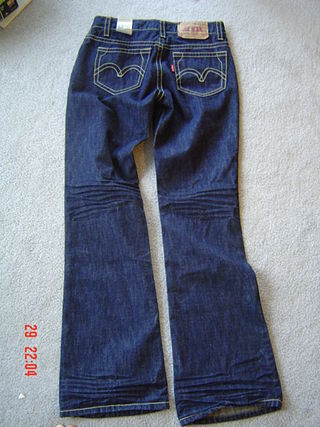
Hip-huggers are pants worn by both men and women, generally made of denim and fitted tightly around the hips and thighs, while usually having flared or bell-bottom lower legs. Hip-huggers were first designed by Irene Kasmer in 1957 in Los Angeles, California. They were worn by the mods in the mid 1960s and into the early 1970s. The late 1970s saw the return of hip-huggers in the disco scene. They were also worn, but to a lesser extent, in the early 1980s, but made a reappearance in the 2000s. The hip-huggers of the 2000s were distinguished by the tightness of the knee, as well as the lower rise of the jeans, typically well below the belly button. This is the product of the boot cut style.

Jodhpurs, in their modern form, are tight-fitting trousers to the ankle, where they end in a snug cuff, and are worn primarily for horse riding. The term is also used as slang for a type of short riding boot, also called a paddock boot or a jodhpur boot, because they are worn with jodhpurs. According to Tara Mayer, "Jodhpurs … exemplify the material and cultural exchanges between Britain and its Indian colony in the nineteenth and early twentieth centuries."

Fashion of the 1980s was characterized by a rejection of 1970s fashion. Punk fashion began as a reaction against both the hippie movement of the past decades and the materialist values of the current decade. The first half of the decade was relatively tame in comparison to the second half, which was when apparel became very bright and vivid in appearance.

The fashion of the 2000's is often described as a global mash up, where trends saw the fusion of vintage styles, global and ethnic clothing, as well as the fashions of numerous music-based subcultures. Hip-hop fashion generally was the most popular among young people of all sexes, followed by the retro inspired indie look later in the decade.

Fashion in the 1970s was about individuality. In the early 1970s, Vogue proclaimed "There are no rules in the fashion game now" due to overproduction flooding the market with cheap synthetic clothing. Common items included mini skirts, bell-bottoms popularized by hippies, vintage clothing from the 1950s and earlier, and the androgynous glam rock and disco styles that introduced platform shoes, bright colors, glitter, and satin.

Slim-fit pants or skinny jeans are tight trousers that have a snug fit through the legs and end in a small leg opening that can be anywhere from 9" to 20" in circumference, depending on size. Other names for this style include drainpipes, stovepipes, tight pants, cigarette pants, pencil pants, skinny pants, gas pipes, skinnies, and tight jeans.

Trousers, slacks, or pants are an item of clothing worn from the waist to anywhere between the knees and the ankles, covering both legs separately. In the United Kingdom, the word pants generally means underwear and not trousers. Shorts are similar to trousers, but with legs that come down only to around the area of the knee, higher or lower depending on the style of the garment. To distinguish them from shorts, trousers may be called "long trousers" in certain contexts such as school uniform, where tailored shorts may be called "short trousers" in the UK.

A fashion boot is a boot worn for reasons of style or fashion. The term is usually applied to women's boots. Fashion boots come in a wide variety of styles, from ankle to thigh-length, and are used for casual, formal, and business attire. Although boots were a popular style of women's footwear in the 19th century, they were not recognized as a high fashion item until the 1960s. They became widely popular in the 1970s and have remained a staple of women's winter wardrobes since then.

The 2010s were defined by hipster fashion, athleisure, a revival of austerity-era period pieces and alternative fashions, swag-inspired outfits, 1980s-style neon streetwear, and unisex 1990s-style elements influenced by grunge and skater fashions. The later years of the decade witnessed the growing importance in the western world of social media influencers paid to promote fast fashion brands on Pinterest and Instagram.
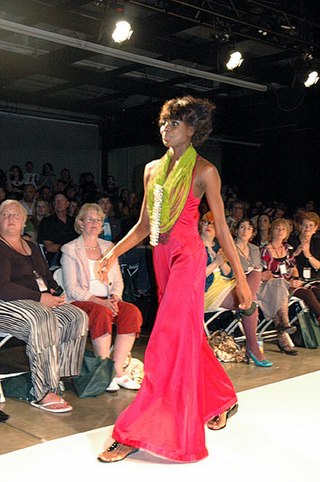
Palazzo pants are long unisex pants cut with a loose, extremely wide leg that flares out from the waist.

Fashion and clothing in the Philippines refers to the way the people of the Philippine society generally dress up at home, at work, travelling and during special occasions.

The fashions of the 2020s represent a departure from 2010s fashion and feature a nostalgia for older aesthetics. They have been largely inspired by styles of the late 1990s to mid-2000s, 1980s, and late 1960s to early 1970s Early in the decade, several publications noted the shortened trend and nostalgia cycle in 2020s fashion. Fashion was also shaped by the COVID-19 pandemic, which had a major impact on the fashion industry, and led to shifting retail and consumer trends.